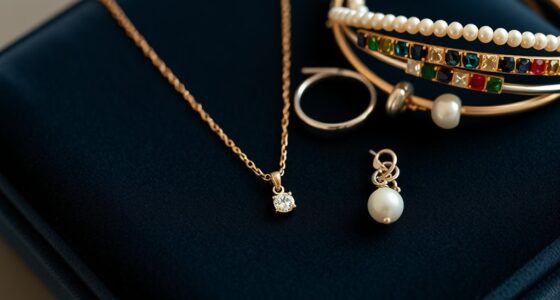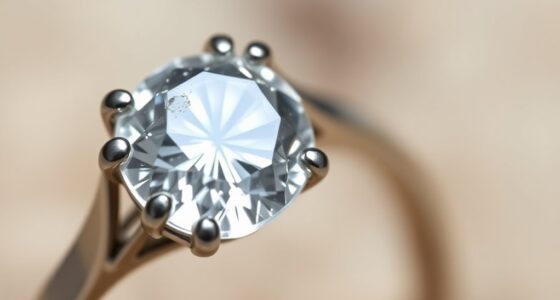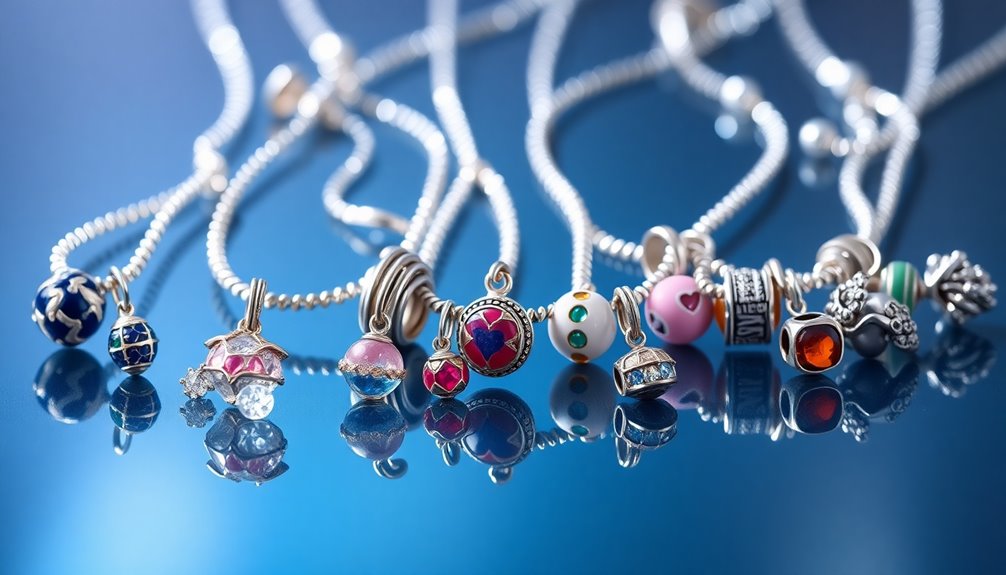Luxury watches blend centuries of craftsmanship, innovation, and tradition. You’ll discover how early mechanical clocks evolved into portable pocket watches, then wristwatches, which became symbols of style and practicality. Swiss brands set standards for precision and artistry through hand-finished movements, complex complications, and high-quality materials like gold, gemstones, and ceramics. The industry now combines traditional techniques with modern innovations and sustainability efforts. Continue exploring to uncover the mastery behind these timeless treasures.
Key Takeaways
- Luxury watches have evolved from early mechanical clocks to portable wristwatches, symbolizing craftsmanship, innovation, and social status.
- Swiss heritage and industry standards emphasize meticulous hand-finishing, high-quality materials, and traditional horological techniques.
- Expert artisans create intricate movements and decorative surfaces using techniques like hand-engraving, polishing, and surface finishing.
- Iconic materials such as gold, platinum, diamonds, and ceramics balance durability, rarity, and aesthetic appeal in luxury designs.
- Innovations like tourbillons, perpetual calendars, and modern materials showcase the blend of traditional craftsmanship and technological advancement.
The Origins of Timekeeping: From Early Clocks to Pocket Watches

Have you ever wondered how timekeeping evolved from massive clocks to portable pieces? The history of horology begins with mechanical clocks in 14th-century Europe, used mainly in churches and public spaces. Early watchmaking introduced portable timepieces like pocket watches in the 16th century, often commissioned by European royalty. These watches showcased artistry in watch design, featuring jewels and intricate engravings, reflecting European craftsmanship. The chronology of timekeeping highlights the progression from stationary clocks to personal devices, culminating in 19th-century watches that combined functionality with decorative appeal. The first wristwatches appeared in 1868, marking a new era of portable timepieces. These innovations laid the foundation for the artistry and precision we associate with luxury watches today. Advancements in watchmaking technology] further refined timepieces, blending engineering excellence with aesthetic appeal.
The Rise of Wristwatches and Their Cultural Significance

Did you ever consider how wristwatches transformed from practical tools into powerful symbols of style and status? Their history reveals a shift from early models, initially seen as women’s accessories, to essential unisex items. During World War I, wristwatches gained popularity among soldiers, emphasizing functionality and convenience. Swiss watchmaking pioneers like Rolex and Patek Philippe elevated wristwatches as symbols of luxury, precision, and social standing. This progression marked a major fashion evolution, making timepieces more accessible and culturally significant. The watch industry thrived on technological innovation, especially during the 1920s and 1930s, when wristwatches became icons of exploration, sports, and modern lifestyle. Today, luxury watches continue to embody both craftsmanship and cultural influence.
Pioneers of Precision: Swiss Watchmaking and Its Legacy
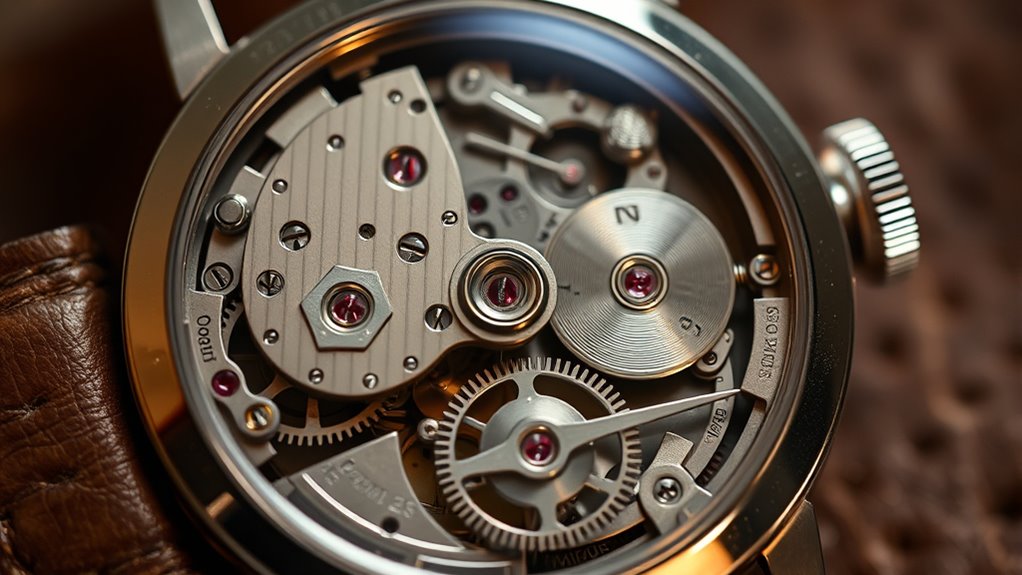
The evolution of wristwatches from symbols of status to symbols of precision owes much to Swiss mastery in watchmaking. Swiss watchmaking, rooted in the 16th century, became renowned for its intricate mechanical movements and innovative heritage techniques. Pioneers like Patek Philippe and Vacheron Constantin revolutionized the industry in the 19th century, focusing on complex movements and exceptional hand-finishing. By the early 20th century, Swiss brands such as Rolex, Omega, and Audemars Piguet set industry standards for precision, durability, and craftsmanship through groundbreaking innovations. The Swiss heritage emphasizes meticulous hand-finishing, high-quality materials, and techniques passed down through generations. This legacy of precision, craftsmanship, and innovation continues to define the reputation of Swiss watchmaking and its enduring influence on luxury watches worldwide. Additionally, the emphasis on heritage techniques has helped preserve traditional skills amidst modern technological advances.
The Evolution of Watch Movements and Technological Innovations

You’ve probably noticed the shift from traditional mechanical movements to highly accurate quartz watches, thanks to technological advances. Innovations like tourbillons and complex complications showcase the mastery behind mechanical craftsmanship, while silicon components improve durability and precision. Understanding these developments helps you appreciate how watchmaking continues to evolve in both artistry and technology. Additionally, advancements in jeep tuning techniques demonstrate the ongoing pursuit of optimizing performance and capability in automotive engineering. As AI security remains a concern, the integration of robust safety measures ensures that technological progress in watchmaking and other fields continues responsibly. Furthermore, implementing quality assurance metrics can help manufacturers monitor and enhance the reliability of their innovations. Staying informed about industry standards is essential for maintaining consistency and excellence in watch craftsmanship.
Mechanical vs. Quartz
Mechanical and quartz watch movements represent two distinct approaches to timekeeping, each with its own strengths and innovations. Mechanical movements showcase intricate craftsmanship, relying on gears, springs, and escapements that embody traditional watchmaking and horological history. Mechanical watches often feature hand-assembled components and meticulous finishing, reflecting centuries of artisanal expertise. Quartz technology, on the other hand, uses electronic components and a quartz crystal to deliver exceptional precision. Imagine:
- A hand-assembled mechanical movement with polished gears and jewel bearings.
- A sleek quartz watch powered by a tiny battery and circuit board.
- A watch featuring complications like tourbillons, demonstrating intricate craftsmanship.
- A modern hybrid combining mechanical elegance with electronic features like Bluetooth connectivity.
- To stay ahead in the industry, enthusiasts often monitor market trends and insights, which influence advancements in watch technology and design. Additionally, ongoing innovations in watch materials continue to shape the durability and aesthetics of modern timepieces. For example, the development of ceramic cases has enhanced both style and resilience in luxury watches.
While mechanical movements prioritize craftsmanship and complexity, quartz technology emphasizes precision and affordability, highlighting the evolution of horological innovation across decades.
Innovations in Complications
Advancements in watch complications have transformed timepieces from simple instruments into intricate marvels of engineering. Innovations like the tourbillon, perpetual calendar, and minute repeater showcase horological mastery through micro-mechanical engineering and precision engineering. The tourbillon, invented by Breguet in 1801, counters gravity’s influence, highlighting intricate functions within mechanical movements. Modern developments include hybrid movements combining mechanical and electronic parts, and silicon components that boost durability and accuracy. These innovations allow for compact, multi-functional cases, elevating craftsmanship to new heights. The integration of silicon components has revolutionized the manufacturing process, allowing for increased precision and reduced wear over time. The ability to innovate while preserving traditional craftsmanship continues to push the boundaries of what is possible in watchmaking. Additionally, the development of advanced materials has contributed to lighter and more resistant parts, further enhancing performance. The ongoing pursuit of technological innovation in horology ensures that watchmaking remains at the forefront of engineering excellence. The table below captures the emotional impact of these advancements:
| Innovation | Significance | Impact |
|---|---|---|
| Tourbillon | Precision under gravity | Mastery of horology |
| Perpetual Calendar | Endless functionality | Timeless accuracy |
| Silicon Parts | Durability and precision | Future of complications |
| Hybrid Movements | Bridging old and new | Endless innovation |
Crafting Excellence: Traditional Techniques and Hand-Finishing Methods

You’ll see that expert artisans spend hours perfecting each component with hand-engraving, polishing, and surface finishing, creating a stunning visual appeal. These traditional techniques add a unique character and allow for customization, making each watch truly one-of-a-kind. By respecting centuries-old methods, brands preserve horological heritage while ensuring exceptional craftsmanship. Engaging with sound design techniques about mastery and dedication can further deepen appreciation for the artistry involved.
Hand-Engraving Techniques
Hand-engraving is a highly skilled craft where artisans use specialized tools like gravers and burins to carve intricate designs directly onto watch cases, dials, and movement components. This meticulous process showcases artisanship and traditional craftsmanship, elevating each piece with decorative motifs that reflect personal or historical significance. As you observe, imagine:
- Artisans delicately wielding precision tools to create fine lines.
- Surface decoration transforming plain surfaces into works of art.
- Engraved motifs like floral patterns or initials adding unique character.
- The careful application of hand-finishing techniques that enhance aesthetic appeal.
- Mastering these techniques requires a deep understanding of personal growth and development, emphasizing patience, skill, and dedication. Additionally, understanding craftsmanship techniques allows artisans to execute their work with precision and artistry.
These handcrafted details are essential to haute horology, demanding artisanal skill and patience. Hand-engraving not only enriches a watch’s visual allure but also signifies exclusivity and mastery within luxury watchmaking.
Polishing and Surface Finishing
After the intricate artistry of hand-engraving, the finishing touches bring a watch’s surface to life with gleaming sophistication. You’ll see skilled artisans perform hand polishing using abrasives like rouge or diamond paste, creating a mirror-like finish that highlights craftsmanship. Surface finishing techniques such as Côtes de Genève and perlage add texture and depth to movement plates and bridges, reflecting horological artistry. Beveling, or anglage, involves carefully polishing and chamfering edges, transforming rough cuts into smooth, reflective surfaces that showcase expert craftsmanship. These traditional techniques demand patience and precision, often taking hours to perfect each detail. Authentic craftsmanship is essential in ensuring each component meets the high standards of luxury watchmaking. The result not only enhances the watch’s beauty but also signifies the high standards of quality and dedication inherent in luxury watchmaking. Additionally, surface finishing plays a crucial role in protecting the watch components from corrosion and wear over time, which is especially important given the delicate nature of precious metals used in luxury watches. Proper application of surface treatments further extends the longevity of the watch, maintaining its pristine appearance for years to come.
Customization and Personalization
Customization and personalization elevate luxury watches from mere timekeeping devices to unique works of art, reflecting your individual style and stories. Through artisanal craftsmanship, you can choose from:
- Intricate hand-finishing like Côtes de Genève, perlage, and anglage, enhancing each component’s visual appeal. Traditional techniques such as these have been perfected over centuries to ensure each detail is refined and precise.
- Bespoke personalization, including engraving by skilled artisans that transforms your watch into a one-of-a-kind masterpiece.
- Custom cases, dial customization, and strap options, allowing you to select materials and designs that suit your taste.
- Meticulous assembly that upholds horological heritage, ensuring a flawless finish and exclusive creation.
- Incorporating traditional techniques and vetted craftsmanship ensures each piece maintains the highest quality standards, honoring heritage and artisanal skill.
These traditional techniques and bespoke services turn an ordinary watch into a reflection of your personality, honoring craftsmanship and heritage.
Iconic Materials and Their Roles in Luxury Watch Design
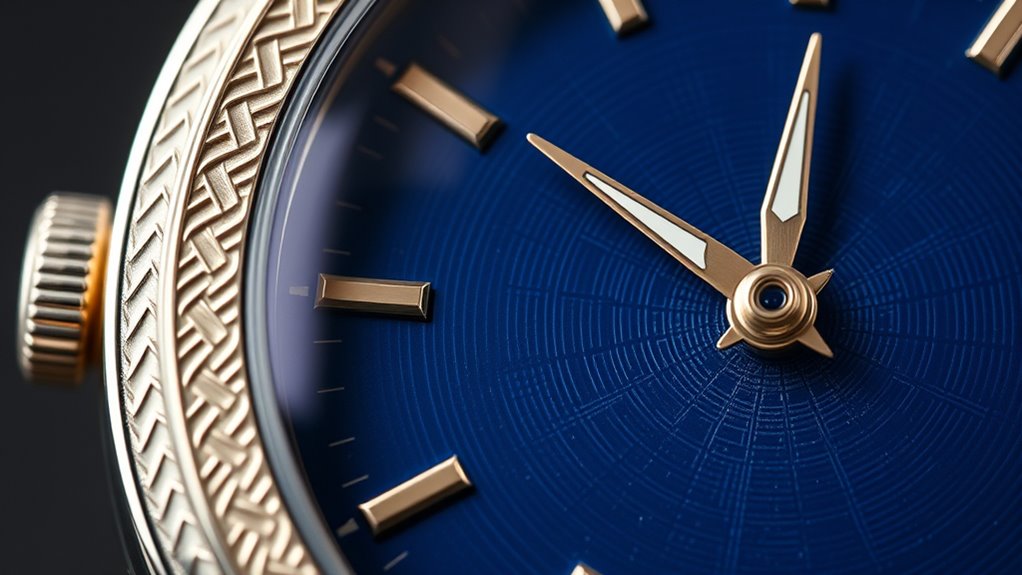
Luxury watch design hinges on the choice of materials that balance durability, beauty, and innovation. Gold, especially 18k yellow, white, and rose, remains a timeless choice for cases and bracelets, combining elegance with resilience. Platinum, prized for its rarity and strength, offers a distinctive, lustrous finish that elevates high-end models. Diamonds and gemstones are carefully set into dials and bezels, enhancing both visual appeal and value. Ceramics, like zirconia, provide scratch resistance, lightweight comfort, and a modern aesthetic in a variety of colors. Advanced materials such as titanium and carbon fiber push the boundaries of design, blending strength with lightweight feel. These materials exemplify craftsmanship, shaping the distinctive look and enduring quality that define luxury watches.
The Art of Complications: Enhancing Functionality and Aesthetic Value
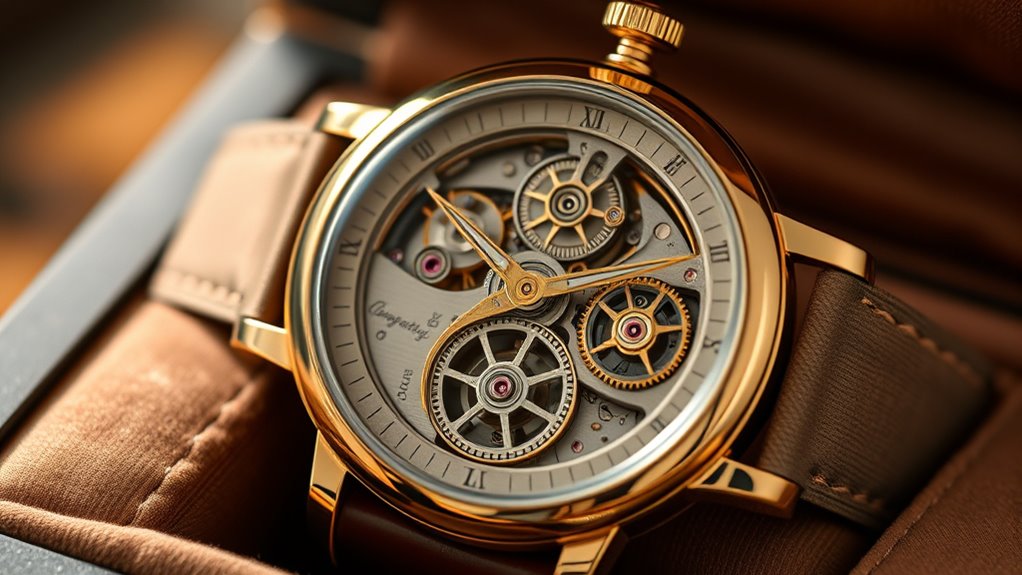
Complications are the intricate mechanisms that transform a watch from simply telling time into a marvel of engineering and artistry. They showcase horological mastery through complex features like moon phases, perpetual calendars, and tourbillons. These intricate mechanisms demand meticulous craftsmanship, often involving hundreds of tiny, precisely assembled parts to guarantee accuracy and reliability. As you explore these features, imagine:
- A visible tourbillon spinning gracefully within the case
- A detailed moon phase display tracking lunar cycles
- A chronograph measuring elapsed time with precision
- Elegant engravings highlighting the craftsmanship behind the mechanics
These complications not only enhance functionality but also elevate aesthetic appeal, turning watch engineering into horological artistry. Their technical innovation reflects a relentless pursuit of perfection, making luxury watches symbols of prestige.
Landmark Brands and Their Contributions to Horological Heritage

Many of the most influential brands in watchmaking have shaped the industry through groundbreaking innovations and timeless designs. Rolex set standards with its waterproof Oyster case and self-winding Perpetual movement, symbolizing durability and prestige. Patek Philippe stands out for its highly complicated, handcrafted timepieces like perpetual calendars, contributing immensely to horological heritage. Audemars Piguet revolutionized luxury sports watches with the Royal Oak, showcasing innovative use of stainless steel and distinctive design. As iconic brands, these luxury watch brands emphasize craftsmanship and precision engineering, elevating watchmaking to an art form. Their innovations have defined industry standards, inspiring generations of horologists. Through their contributions, these brands have cemented their legacy as pioneers in the rich history of horological heritage.
Future Directions: Trends, Sustainability, and Innovation in Watchmaking

The watchmaking industry is increasingly embracing innovative approaches to meet modern demands, blending tradition with cutting-edge technology. You’ll see sustainability take center stage, with brands using recycled metals and ethically sourced gemstones. Innovations like hybrid smartwatches merge mechanical movements with digital features, appealing to tech-savvy consumers. Picture eco-friendly materials such as bio-based plastics and lab-grown gemstones shaping future collections. Advanced manufacturing techniques, including 3D printing and AI-driven design, enable ultra-personalized watches. Imagine:
- Limited-edition collaborations that create exclusivity and excitement.
- Blockchain-based authentication ensuring provenance and authenticity.
- Customization options that allow you to craft a unique piece.
- The rise of smartwatches blending traditional craftsmanship with digital innovation. These trends promise a sustainable, innovative future for luxury watchmaking.
Frequently Asked Questions
How Do Artisans Ensure the Durability of Delicate Watch Components?
You can trust artisans to guarantee the durability of delicate watch components by meticulously selecting high-quality materials, such as corrosion-resistant metals and scratch-proof sapphire crystal. They use precise manufacturing and assembly techniques, like hand-finishing and rigorous testing, to prevent damage and wear. Regular maintenance and expert adjustments also keep the components in top condition, ensuring your luxury watch remains reliable and beautiful for years to come.
What Are the Most Rare and Valuable Materials Used in Luxury Watches?
You’ll find that rare materials like platinum, which is highly durable and scarce, and 18-karat gold, valued for its richness, are common in luxury watches. Additionally, high-grade diamonds and sapphires are used for embellishments and durability. Some watches even incorporate exotic materials like meteorite fragments or rare woods. These materials not only elevate a watch’s value but also guarantee its longevity, making them highly sought after.
How Do Traditional Techniques Influence Modern Watch Design and Production?
You see that traditional techniques like hand-engraving, meticulous assembly, and the use of high-quality materials still shape modern watch design and production. These methods guarantee precision, durability, and a sense of artistry that tech-driven approaches can’t replace. By embracing these timeless skills, you’re assured a watch that’s not only functional but also a unique piece of craftsmanship, blending history with contemporary innovation for a truly luxurious experience.
What Role Does Hand-Finishing Play in a Watch’s Overall Quality?
Hand-finishing plays a vital role in a watch’s overall quality because it directly affects the precision and aesthetic appeal. When you see details like polished edges or engraved surfaces, you’re witnessing craftsmanship that enhances durability and beauty. This meticulous work guarantees each component functions perfectly and looks exceptional, giving you a sense of exclusivity and trust in the watch’s durability and artistry.
How Do Luxury Watch Brands Incorporate Sustainability Into Their Craftsmanship?
You’ll find that luxury watch brands incorporate sustainability by choosing eco-friendly materials, reducing waste, and implementing energy-efficient manufacturing processes. They often source responsibly, using recycled metals and sustainable leather. Many brands also focus on ethical labor practices and transparency in their supply chains. By doing so, they guarantee their craftsmanship not only produces beautiful, high-quality watches but also minimizes environmental impact, aligning luxury with social responsibility.
Conclusion
While some might think luxury watches are just about status, they’re truly masterpieces of craftsmanship and innovation. From centuries-old techniques to cutting-edge technology, each piece tells a story of passion and precision. Don’t dismiss them as mere accessories—you’ll appreciate the artistry and history behind every tick. Investing in a luxury watch means embracing centuries of craftsmanship that’s built to last, blending tradition with future-forward innovation.



